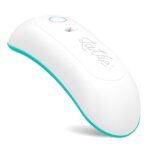Let’s talk about clogged ducts– the bane of existence for many breastfeeding women.
Whether you’re feeding your baby from the breast directly or you’re an exclusive pumper (or a combination of both!), a clogged duct is a possibility.
REAL TALK: Clogged anything isn’t fun. Clogged sinks. Clogged toilets. Not a fun time. But especially a clogged boob…definitely not my jam.
While clogged ducts don’t need to cause immediate concern, they do need to be tended to in an effort to not only clear the clog but also in the hopes of preventing mastitis (a breast infection). A clogged duct tends to cause discomfort. There might be a “bruised” sensation in a certain spot, along with a small lump beneath the surface. The area may be tender, even swollen, or engorged. Now, lactating breasts can feel lumpy, and full breasts may feel a bit uncomfortable. But breasts without a clog will soften during/after nursing (or pumping). If there is a clogged duct, the lump won’t go away and can cause pain. Usually, the pain becomes more intense before and during feeding as the breast is filled with milk (more milk backing up around the clog). The pain may resolve temporarily after a feeding when the breast is “emptied”.
A clogged duct can be both a nuisance and a real pain in the boob. Literally.
Take it from me. A few weeks into my breastfeeding journey, I started experiencing reoccurring clogged ducts. The last thing I had time and energy for trying to manage them. So I began trialing and error-ing my way through looking for what worked- for both my sanity, and also for the sake of continuing on in my breastfeeding journey.
A few things before getting to it…
Disclaimer: Please note: This post is for education and inspiration purposes only. I am sharing what has worked for me. This should not serve as or replace medical advice by a licensed provider. Please consult your doctor when making changes to your routine and deciding what’s best for you.
Now that that’s out of the way, let’s get to it!
a little about clogged ducts
The main reason for a clogged duct is inflammation in the breast tissue surrounding the milk ducts. A clogged duct may also be referred to as a “plugged duct” or a “blocked duct”. Regardless of the verbiage, we want that milk flowing, not stuck!
Clogged ducts can happen for a variety of reasons, most of which are rooted in inadequate removal of milk from the breast. There are several reasons this may happen. Common culprits include:
- abrupt changes in a baby’s feeding schedule or pump schedule/ going too long between feeds or pumping (i.e. baby starts sleeping more, Mom misses pump breaks at work)
- poor or restrictive latch with nursing (there may be a tongue-tie or tightness impacting the latch and preventing adequate emptying of the breast)
- distracted or “sleepy” nursing sessions (like if baby becomes distracted during feeds, or baby gets sleepy at the breast)
- too much pressure on the breast (could be from sleeping on your stomach or something like wearing super restrictive bras)
- less effective pumping (could be from ineffective pump parts such as valves & membranes that need to be replaced, or it may even be that Mama is not using the correct flanger size for her)
Essentially, the chances of getting clogged ducts increase when nursing/pumping is ineffective at removing milk consistently.
–> For nursing Mamas, never underestimate the power of a good, deep latch. For support in evaluating latch, working with an IBCLC to evaluate a baby’s latch can be an invaluable resource. I’ll be sharing my experience working with an IBCLC soon!
–> For pumpin’ Mamas, be sure to check how often you need to replace pump parts to keep things functioning optimally for removing milk. Pumps usually come with a user manual that includes information on this. It’s also important to use your correct flange size to maximize milk output. Legendairy Milk has a free nipple ruler download on their website to help with this, or you can use this link to order one like I did (because I’m that weird Mom-friend that wants to help measure her friend’s nips if needed).

Disclosure: post may contain affiliate links which means sales made through such links will reward me with a small commission. As an Amazon Associate, I earn from qualifying purchases.
so what’s a girl to do about it?
A simple web search will pull up all sorts of remedies for clogged ducts. Here’s what has worked for me:
before nursing/pump sessions:
HEAT: Apply heat on top of the clog for 15-20 minutes before nursing/pumping. Heat helps the blood vessels dilate/open up which increases blood flow to the area for healing. You could try using a warm compress or taking a warm shower and letting the warm water run right over the site. Warm, moist heat is the way to go here!
I have also found it helpful to bring a manual hand pump or my Haaka into the warm shower with me. For warm compress options, you could try a rice sock, hot water bottle pack, or heating pad. I’ve also done a disposable diaper trick. This is where you run warm water into the diaper, wring it out a bit, and apply this to the breast by tucking it into the bra. It conforms to the breast and holds in the heat quite well!
GENTLE MASSAGE: While in a warm shower before the nursing/pump session, or during the session, it can help to gently massage above and below the clog towards the nipple to help loosen things up. If you can hand express in the shower and get milk moving, that can help too. I also got one of these breast massage rollers from Legendairy Milk, too. *Be mindful of the amount of pressure- it does not need to be, nor should it be forceful or intense pressure. Too much pressure may cause more inflammation.
Using lactation massagers can also help here and are rather convenient. I picked this one up online. Shortly after a friend gifted me a set of LaVie 2-in-1 Warming Lactation Massagers, which ended up being my favorite to use. They were like my little breast friends during a few weeks of reoccurring clogged ducts.
 LaVie 2-in-1 Warming Lactation Massagers
LaVie 2-in-1 Warming Lactation Massagers
Don’t have fancy boob massagers but have an electric toothbrush? Try placing the back of the head of the toothbrush on the clog and use it to gently massage the area. The targeted vibrations may help loosen things up and encourage the clog to make its way down the duct. I totally tried this before the massagers came in.
NURSE, PUMP, GET THINGS MOVING: With a clogged duct, many find that the letdown is the more painful/uncomfortable part of a nursing session. If so, it may help to start the baby on the side without the clog for the letdown, and then immediately switch to the breast with the clog. Because their jaw applies the most pressure, it may be helpful to aim the baby’s jaw toward the clogged duct. We want to minimize further buildup around the clog, so making sure the breast is being drained is important.
I nursed or pumped every two to three hours (max) to keep my breast as “empty” as possible (even though they’re really never completely empty). Sometimes this meant pumping a little after a feed if my baby didn’t nurse much or fell asleep at the boob. A few times a day, I would also dangle nurse/pump. This uses gravity to work with the baby’s suction in moving the clog outward. *Carefully* position yourself on all floors and hang your boob down to meet baby’s mouth below. Yes, yes you will feel like an actual cow.
For pumping, I used this same method by leaning over a Haaka or flange. When your determination to get the clogs out overrides any care in the world about how you look, you’ll do anything.
after & between nursing/pump sessions:
ICE: After feeds or pump sessions, we want to focus on decreasing inflammation. A great way to do this is by using ice or cooling packs. These can be applied on top of the clog and tucked in a bra for 10-15 minutes after feeds. Having an ice roller (like this one) also comes in handy. It was easier for me to grab it out of the freezer and start rollin’! When in doubt, a bag of good ole’ frozen peas do the trick nicely as well.

Lansinoh TheraPearl 3-in-1 Hot or Cold Breast Therapy Pack
REST: Prioritizing rest as much as you can is supportive. As a mother, it can be easier said than done- I get it. But try your best and get in even a quick nap when the baby does. Don’t feel bad asking for help from your partner or supportive community.

a few other things I’ve used…
Haaka Epson salt soak: Fill a Haaka Silicone with warm water and a little Epsom salt and suction onto the affected breast. The suction from the Haaka can help pull the clog outward. This is the kind I use, but they also have ones with a suction base to prevent spills (so helpful when using outside of clog issues when handling your precious liquid gold!). I tried this 1-2 times a day for about 10-15 minutes.
“Boob soup”: One time I couldn’t find my Haaka so I grabbed a bowl, filled it with very warm water and a little Epsom salt, set it on the counter, leaned over that sucker, and started gently massaging my boob. My eight-year-old walked in and asked what I was doing. He said it looked like I was making “boob soup”. The name was coined!
Castor oil pack: Fold a washcloth (I used one that I don’t mind getting stained) and dampen it with warm water. Drizzle on some Castor Oil. Place this over the clog and cover it with a little plastic/towel. Set a warm heating pad over it for about 10- 15 minutes (could also warm up the oil first). Remove and wash castor oil off with soap & water before breastfeeding or pumping. I have used products both from Queen of Thrones and Heritage Store (I have used their little roll-on Castor oil for a few things and find it convenient).
additional support
There are a few things I have taken with good results while managing clogged ducts.
WishGarden Herbs has a Happy Ducts Tincture that I found helpful for stubborn clogs. I’d usually order supplements from the site directly or through one of my online dispensaries, but I got this with the fast Amazon shipping since I was in a pinch. After having a very painful clog for a second time, I tried this and within a few hours, it was unclogged- talk about sweet relief! I used it as directed on the bottle.
Earthley Wellness makes a Milk Flowin’ Salve to help keep lymphatic fluids and milk moving. A little can be massaged into any lumps or sore spots on the breast.
Sunflower Lecithin is a popular recommendation for clogged ducts as it is a natural fat emulsifier and may help reduce the “stickiness” of the milk so it’s less likely to get clogged up. The same sweet friend that blessed me with the set of lactation massagers also sent me a bottle of Legendairy Milk’s Sunflower Lecithin. I have taken a few capsules a day without any issues when I have had clogs. However, it’s worth mentioning that for some folks (usually using it longer-term) it may cause digestive upset. After discussing with my IBCLC that it’s really the CHOLINE we want (sunflower lecithin breaks down into choline), I decided not to take it long-term/when I do not have a clogged duct. Instead, I make sure I’m consuming choline in my diet (dairy, egg yolks, organ meats, dark leafy greens, chicken, and fish are all natural sources). For some, it may be beneficial to consider a choline supplement or a prenatal that contains enough choline.
Though it’s not the first thing I reach for (as needed) Ibuprofen may help in decreasing inflammation and pain. During peaks in symptoms, I did take a little Ibuprophen to help with pain management.
Because diet is such a foundation piece to well-being, I also make sure to consume anti-inflammatory foods (i.e. fatty fish, green leafy vegetables, citrus fruits, berries) and choline-rich foods/supplements (eggs, beef liver capsules, cod liver oil, etc.).
I’ve known women that find making a poultice or compress using anti-inflammatory herbs (like calendula & chamomile), support lymphatic circulation (like yarrow & burdock root), and help draw out any infection (like marshmallow root & slippery elm) to be helpful as well. A poultice can be made by pouring boiling water over the herbs and letting them steep for about 10-15 minutes. Once it’s able to be handled, you could dip a clean cotton cloth into the mixture, apply it over the site like a poultice, and even wrap it around the breast. Leave it on until it cools and remove.
Yeah…sometimes managing clogged ducts feels like a part-time job. But with intention, the sooner you address it, the more likely things will UN-clog and, better yet, not develop into mastitis.
NOTE: With treatment, most clogs will resolve within a day or two. If it does not resolve within a few days (a week at most), if additional symptoms (redness, warmth, swelling, fever, or chills) occur, or if clogged ducts continue to be reoccurring, make sure to reach out to your healthcare provider to discuss options for further evaluation and treatment options. Make sure to discuss changes to your routine with your appropriate provider.
a few more tidbits (or should I say titbits :P)
In my opinion, sometimes the best defense is a good offense. To help reduce the chance of getting a clogged duct, here are some things to prioritize:
-> be mindful of how long you go between nursing/pumping sessions (this will vary depending on the baby’s age and feeding frequency so keep this in mind. When my son was a newborn, I was at least nursing or pumping every 2-3 hours).
-> wearing comfortable, well-fitting bras that are not too restrictive. I avoid ones with underwire and wearing tight sports bras for long periods of time. Some of my favorite nursing and pump bras are from Kindred Bravely (use discount code: Maddie15) and Bodily (not affiliated, I just really like their Everything Bra).
-> regularly performing “breast gymnastics” or lymphatic breast massages! Gently moving the breasts up and around helps get things moving and also elongates the milk ducts. Check out this video about breast gymnastics. Here’s one I referenced for a simple lymphatic drainage technique. I do these often as a part of my “self-care” routine.
-> staying hydrated and making sure to prioritize rest is a necessity- not just for clogged ducts, but in general!
(Knock on wood)…since implementing all of the above (and getting in choline-rich foods in my diet as mentioned earlier), I have not had a clogged duct in a bit. And hoping it stays that way!
I hope something here helps you out as well!
-Your (Mama) Friend, Maddie




